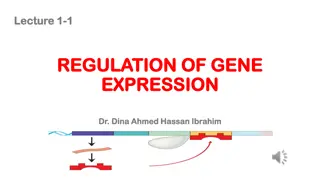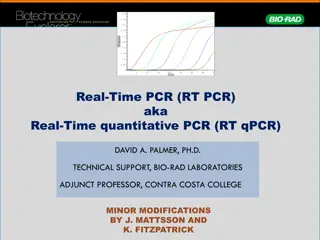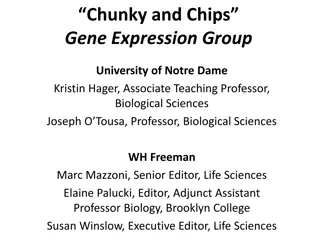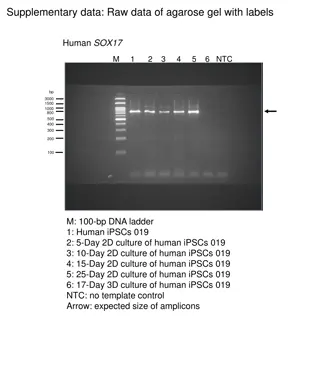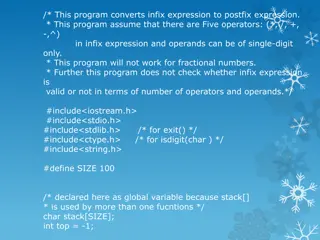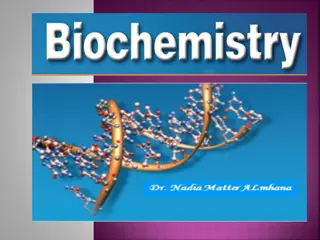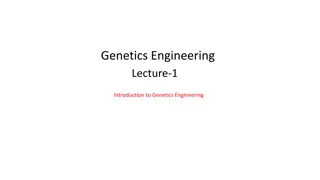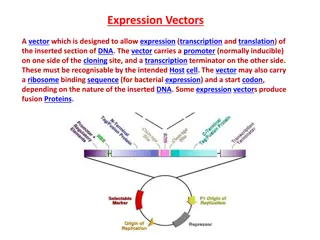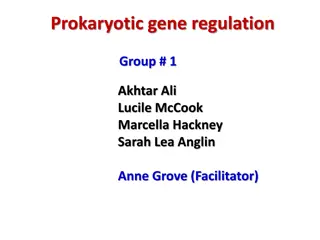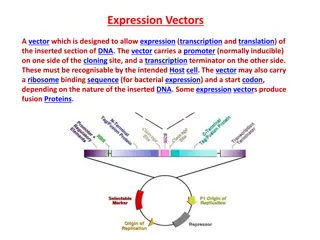Understanding Gene Regulation and Control of Gene Expression
This comprehensive content delves into the intricate mechanisms of gene regulation and control of gene expression. It covers topics such as transcriptional regulation, bacterial genes classification, and the role of regulatory proteins. Explore how genes are regulated at transcription, translation, and post-translational levels. Understand the significance of constitutive genes and operons in maintaining cellular homeostasis.
- Gene regulation
- Control of gene expression
- Transcriptional regulation
- Bacterial genes
- Regulatory proteins
Download Presentation

Please find below an Image/Link to download the presentation.
The content on the website is provided AS IS for your information and personal use only. It may not be sold, licensed, or shared on other websites without obtaining consent from the author. Download presentation by click this link. If you encounter any issues during the download, it is possible that the publisher has removed the file from their server.
E N D
Presentation Transcript
Gene regulation Gene regulation
Control of Gene Expression Control of Gene Expression Controlling gene expression is often accomplished by controlling transcription initiation. Regulatory proteins bind to DNA to either block or stimulate transcription, depending on how they interact with RNA polymerase. Prokaryotic organisms regulate gene expression in response to their environment. Eukaryotic cells regulate gene expression to maintain homeostasis in the organism. Gene expression is often controlled by regulatory proteins binding to specific DNA sequences. regulatory proteins gain access to the bases of DNA at the major groove regulatory proteins possess DNA-binding motifs (regions of regulatory proteins which bind to DNA)
Bacterial genes Bacterial genes can be classified according to their expression into: A constitutive gene is a gene that is transcribed continually as opposed to an inducible gene, which is only transcribed when needed. A housekeeping gene is typically a constitutive gene that is transcribed at a relatively constant level. The housekeeping gene's products are typically needed for the maintenance of the cell. It is generally assumed that their expression is unaffected by experimental conditions. An inducible gene is a gene only transcribed when needed as opposed to a constitutive gene. An inducible gene is a gene whose expression is either responsive to environmental change or dependent on the position in the cell cycle.
Gene regulation Gene regulation Constitutive Genes = unregulated essentially constant levels of expression (often required in the cell all the time ) Regulation can occur at: Transcription (regulatory proteins; attenuation) Translation (repressors; antisense RNA) Post translational (feedback inhibition)
Transcriptional Regulation Transcriptional Regulation Control of transcription initiation can be: positive control increases transcription when activators bind DNA negative control reduces transcription when repressors bind to DNA regulatory regions called operators Prokaryotic cells often respond to their environment by changes in gene expression. Genes involved in the same metabolic pathway are organized in operons. Some operons are induced when the metabolic pathway is needed. Some operons are repressed when the metabolic pathway is no longer needed
Operon Operon is a functioning unit of DNA containing a cluster of genes under the control of a single promoter. The genes are transcribed together into an mRNA strand and either translated together in the cytoplasm called polycistronic mRNA, or undergo splicing to create monocistronic mRNAs that are translated separately, i.e. several strands of mRNA that each encode a single gene product. The result of this is that the genes contained in the operon are either expressed together or not at all.
operons in in as fly, Drosophila melanogaster). In general, the expression of prokaryotic operons leads to the generation of polycistronic mRNAs(a single mRNA molecule that codes for more than one protein), while eukaryotic operons lead to monocistronic mRNA (a single mRNA molecule that codes for one protein). Operons are also found in viruses such as bacteriophages were thought but ( to exist exist solely also such prokaryotes, eukaryotes Caenorhabditis elegans and the fruit operons nematodes
General structure of operon: Promoter a nucleotide sequence recognized by RNA polymerase, which then initiates transcription. In RNA synthesis, promoters indicate which genes should be used for messenger RNA creation and, by extension, control which proteins the cell produces. Operator a segment of DNA that a repressor binds to. It is classically defined in the lac operon as a segment between the promoter and the genes of the operon. In the case of a repressor, the repressor protein physically obstructs the RNA polymerase from transcribing the genes. Structural genes the genes that are co-regulated by the operon.
Lac operon Lac operon The lac operon (lactose operon) is an operon required for the transport and metabolism of lactose in Escherichia coli and many other enteric bacteria. Although glucose is the preferred carbon source for most bacteria, the lac operon allows for the effective digestion of lactose when glucose is not available. Bacterial operons are polycistronic transcripts that are able to produce multiple proteins from one mRNA transcript. In this case, when lactose is required as a sugar source for the bacterium, the three genes of the lac operon can be expressed and their subsequent proteins translated: lacZ, lacY, and lacA. The gene product of lacZ is - galactosidasewhich cleaves into glucose and galactose. lacY encodes lactose permease, a protein that becomes embedded in the cytoplasmic membrane to enable the transport of lactose into the cell. Finally, lacA encodes galactoside O-acetyltransferase. lactose, a disaccharide,
The lac Operon Is Regulated By a Repressor Protein The lac Operon Is Regulated By a Repressor Protein The lac operon can be transcriptionally regulated 1. By a repressor protein 2. By an activator protein The first method is an inducible, negative control mechanism It involves the lac repressor protein The inducer is allolactose It binds to the lac repressor and inactivates it
Constitutive expression The lac operon now is repressed Therefore no allolactose
The lac operon now is induced The conformation of the repressor is now altered Repressor can no longer bind to operator Some gets converted to allolactose
The lac Operon Is Also Regulated By an Activator The lac Operon Is Also Regulated By an Activator Protein Protein catabolite repression When exposed to both lactose and glucose E. coli uses glucose first, and catabolite repression prevents the use of lactose When glucose is depleted, catabolite repression is alleviated, and the lac operon is expressed The sequential use of two sugars by a bacterium is termed diauxic growth
Regulation involves a small molecule, cyclic AMP (cAMP) produced from ATP via the enzyme adenylyl cyclase cAMP binds an activator protein known as the Catabolite Activator Protein (CAP) cAMP-CAP complex is an example of genetic regulation that is inducible and under positive control The cAMP-CAP complex binds to the CAP site near the lac promoter and increases transcription In the presence of glucose, the enzyme adenylyl cyclase is inhibited This decreases the levels of cAMP in the cell Therefore, cAMP is no longer available to bind CAP And Transcription rate decreases







